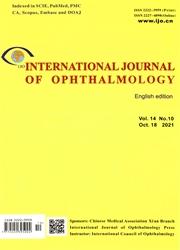Acute primary angle closure during the Omicron outbreak
IF 1.9
4区 医学
Q2 OPHTHALMOLOGY
引用次数: 0
Abstract
AIM: To investigate Omicron's impact on clinical presentation of acute primary angle closure (APAC) in China. METHODS: A consecutive case series with historical controls was conducted at Shenzhen Eye Hospital, the largest specialized hospital in Shenzhen, China. Medical records from a two-month period during the Omicron pandemic (December 1, 2022, to January 31, 2023) were compared with records from two control groups (12/2018–1/2019 and 12/2021–1/2022) before pandemic. Patients with APAC were included, and the prevalence of APAC and demographic characteristics in Omicron-infected and non-infected patients were compared. RESULTS: Seventy-one (23.43%) out of 303 patients were diagnosed with APAC in the pandemic cohort, which was 2.98 and 2.61 times higher than that in control cohorts (7.87% in 2019, 8.96% in 2022, P<0.001). The pandemic cohort has significantly higher Omicron-infected rate (78.87% vs 0 vs 0; P<0.001), lower proportion of glaucoma history (16.90% vs 42.86% vs 41.67%, P=0.005), higher surgical rate (95.77% vs 83.33% vs 78.57%, P=0.024), higher total medical costs and larger pupil diameter (5.63±0.15 vs 4.68±0.15 vs 4.69±0.22 mm, P<0.01). In 83% Omicron-infected patients, ocular symptoms appeared within 3d after systemic symptoms onset. In multivariate analysis, Omicron infection (P<0.001) was the only independent predictor of pupil diameter. CONCLUSION: In the Omicron epidemic in China, there is an increase of prevalence and severity of APAC, particularly focusing on the first 3d following infection.欧米茄爆发期间的急性原发性角膜闭合
目的:研究欧米龙对中国急性原发性角膜闭合(APAC)临床表现的影响。方法:在中国深圳最大的眼科专科医院深圳眼科医院开展了一项连续病例系列研究,并进行了历史对照。将奥米克大流行期间(2022 年 12 月 1 日至 2023 年 1 月 31 日)两个月的病历与大流行前两个对照组(12/2018-1/2019 和 12/2021-1/2022)的病历进行比较。结果:大流行组 303 名患者中有 71 人(23.43%)被确诊为 APAC,分别是对照组的 2.98 倍和 2.61 倍(2019 年为 7.87%,2022 年为 8.96%,P<0.001)。大流行队列的欧姆龙感染率明显更高(78.87% vs 0 vs 0;P<0.001),青光眼病史比例更低(16.90% vs 42.86% vs 41.67%,P=0.005)、更高的手术率(95.77% vs 83.33% vs 78.57%,P=0.024)、更高的医疗总费用和更大的瞳孔直径(5.63±0.15 vs 4.68±0.15 vs 4.69±0.22 mm,P<0.01)。83%的奥美康感染者在全身症状出现后3d内出现眼部症状。在多变量分析中,奥米克龙感染(P<0.001)是瞳孔直径的唯一独立预测因素。
本文章由计算机程序翻译,如有差异,请以英文原文为准。
求助全文
约1分钟内获得全文
求助全文
来源期刊

International journal of ophthalmology
Medicine-Ophthalmology
CiteScore
2.50
自引率
7.10%
发文量
3141
审稿时长
4-8 weeks
期刊介绍:
· International Journal of Ophthalmology-IJO (English edition) is a global ophthalmological scientific publication
and a peer-reviewed open access periodical (ISSN 2222-3959 print, ISSN 2227-4898 online).
This journal is sponsored by Chinese Medical Association Xi’an Branch and obtains guidance and support from
WHO and ICO (International Council of Ophthalmology). It has been indexed in SCIE, PubMed,
PubMed-Central, Chemical Abstracts, Scopus, EMBASE , and DOAJ. IJO JCR IF in 2017 is 1.166.
IJO was established in 2008, with editorial office in Xi’an, China. It is a monthly publication. General Scientific
Advisors include Prof. Hugh Taylor (President of ICO); Prof.Bruce Spivey (Immediate Past President of ICO);
Prof.Mark Tso (Ex-Vice President of ICO) and Prof.Daiming Fan (Academician and Vice President,
Chinese Academy of Engineering.
International Scientific Advisors include Prof. Serge Resnikoff (WHO Senior Speciatist for Prevention of
blindness), Prof. Chi-Chao Chan (National Eye Institute, USA) and Prof. Richard L Abbott (Ex-President of
AAO/PAAO) et al.
Honorary Editors-in-Chief: Prof. Li-Xin Xie(Academician of Chinese Academy of
Engineering/Honorary President of Chinese Ophthalmological Society); Prof. Dennis Lam (President of APAO) and
Prof. Xiao-Xin Li (Ex-President of Chinese Ophthalmological Society).
Chief Editor: Prof. Xiu-Wen Hu (President of IJO Press).
Editors-in-Chief: Prof. Yan-Nian Hui (Ex-Director, Eye Institute of Chinese PLA) and
Prof. George Chiou (Founding chief editor of Journal of Ocular Pharmacology & Therapeutics).
Associate Editors-in-Chief include:
Prof. Ning-Li Wang (President Elect of APAO);
Prof. Ke Yao (President of Chinese Ophthalmological Society) ;
Prof.William Smiddy (Bascom Palmer Eye instituteUSA) ;
Prof.Joel Schuman (President of Association of University Professors of Ophthalmology,USA);
Prof.Yizhi Liu (Vice President of Chinese Ophtlalmology Society);
Prof.Yu-Sheng Wang (Director of Eye Institute of Chinese PLA);
Prof.Ling-Yun Cheng (Director of Ocular Pharmacology, Shiley Eye Center, USA).
IJO accepts contributions in English from all over the world. It includes mainly original articles and review articles,
both basic and clinical papers.
Instruction is Welcome Contribution is Welcome Citation is Welcome
Cooperation organization
International Council of Ophthalmology(ICO), PubMed, PMC, American Academy of Ophthalmology, Asia-Pacific, Thomson Reuters, The Charlesworth Group, Crossref,Scopus,Publons, DOAJ etc.
 求助内容:
求助内容: 应助结果提醒方式:
应助结果提醒方式:


